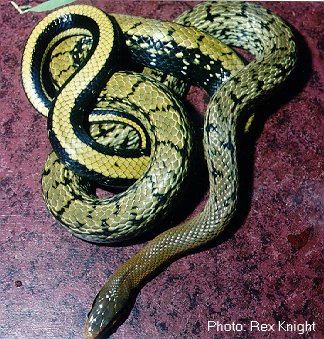 |






(Click on small pictures to view larger version)
| Scientific Name: | Elaphe taeniura (Cope, 1861) |
| Common Names: | Beauty Snake, Stripe-tailed Ratsnake |
| Subspecies: |
Elaphe taeniura taeniura (Cope, 1861) Elaphe taeniura friesi (Werner, 1926) Elaphe taeniura mocquardi (Moquard, 1905) Elaphe taeniura schmackeri (Boettger, 1895) Elaphe taeniura yunnanensis (Anderson, 1879) Elaphe taeniura grabowskyi (Fischer, 1885) Elaphe taeniura ridleyi (Butler, 1899) Elaphe taeniura ssp. |
| Size: | 130 to 250 cm, varies with subspecies |
| Distribution: |
E. t. taeniura: China, eastern China including Beijing, Anhui, Fujian, Hebei, Hunan, Jiangsu, Jiangxi, and Zhejiang provinces.
E. t. yunnanensis: Northwestern India, Darjiling and Assam areas. Northern Burma, Northern Thailand, Northern Laos, North Vietnam. Western Central China including the provinces of Gansu, Guizhou, Shaanxi, Sichuan, Yunnan and Xizang. E. t. grabowskyi: Indonesian islands of Sumatra and Borneo. E. t. schmackeri: Japanese islands of Haterumajima, Irabujima, Iriomotejima, Ishigakijima, Kohamajima, Kurimajima, Miyakojima and Shimjishima. These islands form the Ryu Kyu archipelago, a small group of islands northeast of Taiwan. E. t. ridleyi: Southern peninsula of Thailand and peninsula Malaysia. E. t. mocquardi: Southeastern China including southern Fujian, Guangdong, Guangxi and Hainan provinces. Northern Vietnam. E. t. friesi: The Island of Taiwan. E. t. ssp: Western Thailand and adjacent Burma. |
| Other Info: |
Elaphe taeniura, the beauty snake is a large and slender ratsnake ranging from 4½ - 8 ft (139cm-250cm), in length. They are active during the day as well as at night and can be found in a great varity of habitats ranging from forest to cultivated fields to human settlements to caves. E. t. ridleyi is known as the cave dwelling ratsnake, as it is often collected deep with in caves.
Beauty snakes, also known as Striped tailed racers, are a very interesting ratsnake to keep and breed. Most subspecies are available and easy to mantain. Since they are a larger species, provide them with a large terrarium with good hiding places and a large water bowl. They will make use of branches for climbing. Mating usualy takes place in the spring with eggs (9-20 depending on the subspecies) being laid in mid July to early August. Juveniles are very hardy, readily accept new born mice, and grow quickly. All subspecies, except for E. t. ridleyi and E. t. grabowskyi, should be hibernated for 2-4 months, maybe even a little longer for E. t. yunnanensis, since they are a more montane form. E. t. ridleyi and E. t. grabowskyi are from Malaysia and Indonesia where there really is no cold winter, and they inhabit caves where the temperature is cooler than the outside. I find that my E. t. ridleyi like a little cooler temperature, and they also like a higher humidity. E. taeniura is a great ratsnake for the beginner of Asian Elaphe species, they tame easy and will make great pets. There is a large variance in size with the different subspecies. While most specimens of E. t. taeniura and E. t. yunnanensis average around 5ft., specimens of E. t. ridleyi and E. t. friesi may reach as much as 8ft or more. I've heard of an E. t. ridleyi that was just under 10ft(!), and I've also heard of several reports of the "Blue Beauty" variety that have been in the 8ft plus range. Also, as with many of the ratsnakes, the color and pattern can vary quite a bit even within the subspecies, especially with E. t. yunnanensis, since they cover such a wide range. We've also seen a number of color morphs, including albino, hypomelanistic, melanistic, patternless, and calico. One could devote their entire hobby to just this large fascinating species. Hopefully we'll see some E. t. grabowskyi and E. t. schmackeri available soon. |
